Art dances to nature’s tune at the Palmer Sculpture Biennial
Be a ‘Palmer Pilgrim’ and explore this enticing sculpture showcase where 19 artists have co-opted the dramatic hilly landscape to play along with their imaginative ideas – including visions of an alternative future.

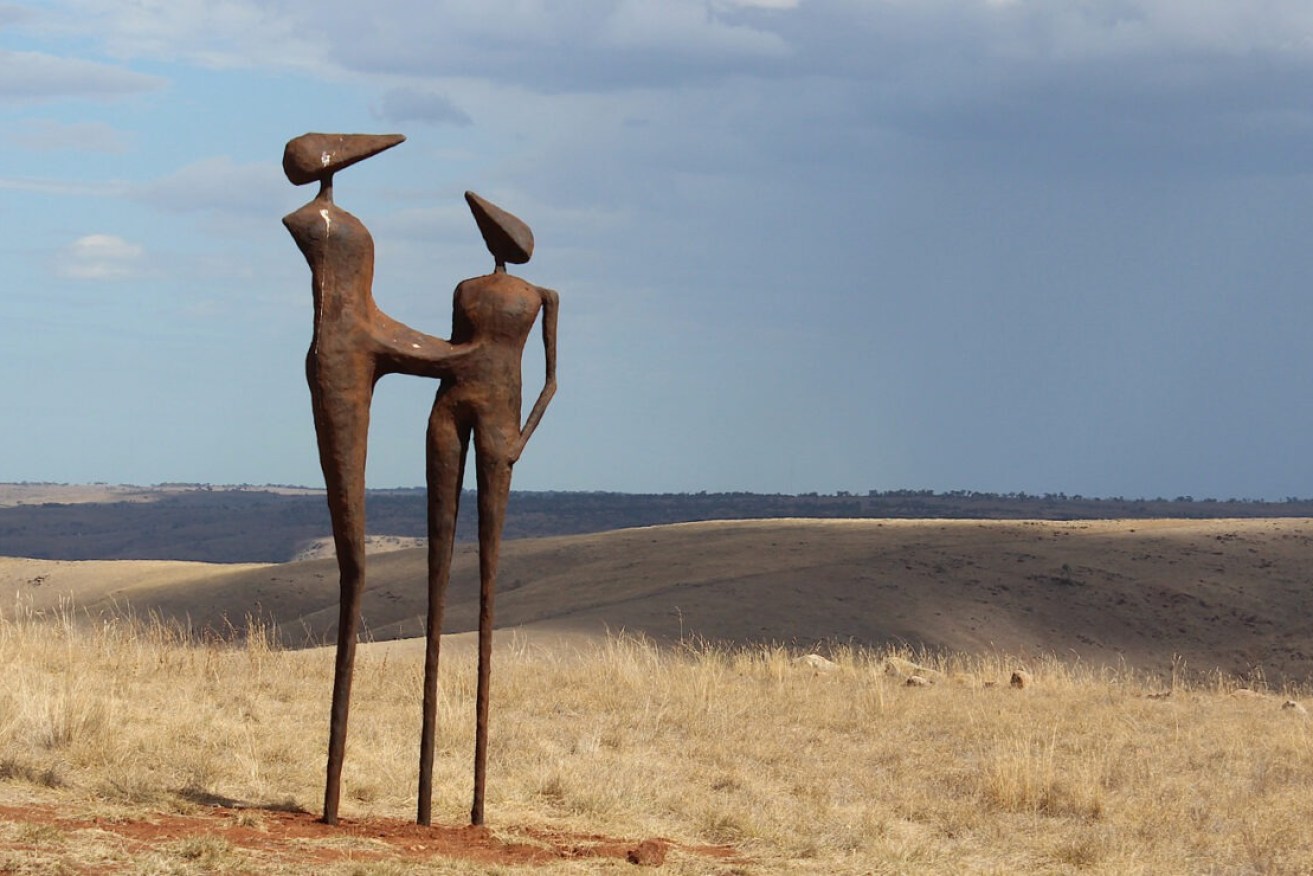
Sian Watson's 'Gathered Skylark' makes the most of its ridge-top siting. Photo: John Neylon
Palmer. It’s that small town at the bottom of the drop down on from Tungkillo to the ancient Murray River plains. Artist Greg Johns bought a property here in 2001. This is rain shadow country, exposed to the elements where even the rocks lean away from the wind. Decades of land clearance and overgrazing have stripped it to its bones.
What was the attraction? Johns had a vision. This would be a place where art, sculptural art in particular, could say something about a sense of place – to be, in fact, authentically Australian.
The total Palmer package would include rebirthing this site as a “returning landscape”, reintroducing plants native to the area. The thousands of planted trees, bushland and grasses are now maturing. Birds are returning. So, three cheers for nature and the efforts made by many to restore it. But what about the art?
The Palmer Sculpture Biennial, which has been running since 2004, was conceived to allow the wider art community to experience sculpture in a dramatic “beyond the walls” setting, and also assess for itself the idea that in a digitised world, site-specific art objects have agency.
This year marks the 11th Palmer Sculpture Biennial. Nineteen artists from interstate, overseas and within South Australia are represented. Stelarc, best-known for his work reimaging the human body through robotics and interrogating related AI and virtual systems, is this Biennial’s Honoured Artist.
In the controlled space of the white cube gallery even the most inexperienced artist can create little visual and conceptual games to entertain viewers. But in Palmer’s unforgiving landscape, art works must fight to survive. Art will always dance to nature’s tune in this place. Scale plays tricks on the eyes. On hot days, solid forms dissolve into shimmering chimera. Shadows shrink to knife slits or run from the setting sun like skid marks on hard top. Painstakingly conceived sculptures can be reduced to dashes and dots on an epic canvas defined by a land mass meeting the sky.
In response, most artists have adopted ways to insinuate their work and ideas into not one big, amorphous landscape but multiple landscapes – ridges, soaks, escarpments, tumble-downs, slopes and gullies. Insinuation involves subtle gestures of relationship that are tantamount to asking permission to enter country. To show respect. There are many examples. Liz Butler’s On Reflection is basically a modified discarded rainwater tank, lying on its side with one end stoved in. The artist was thinking of the importance of water in early settlement – thus the choice of the tank. By inserting a mirrored base, partially seen through the corroded base, the viewer is rewarded with a reflection of self and landscape and, in the mind of the artist, “an invitation to consider responsibility in protecting the natural environment”.
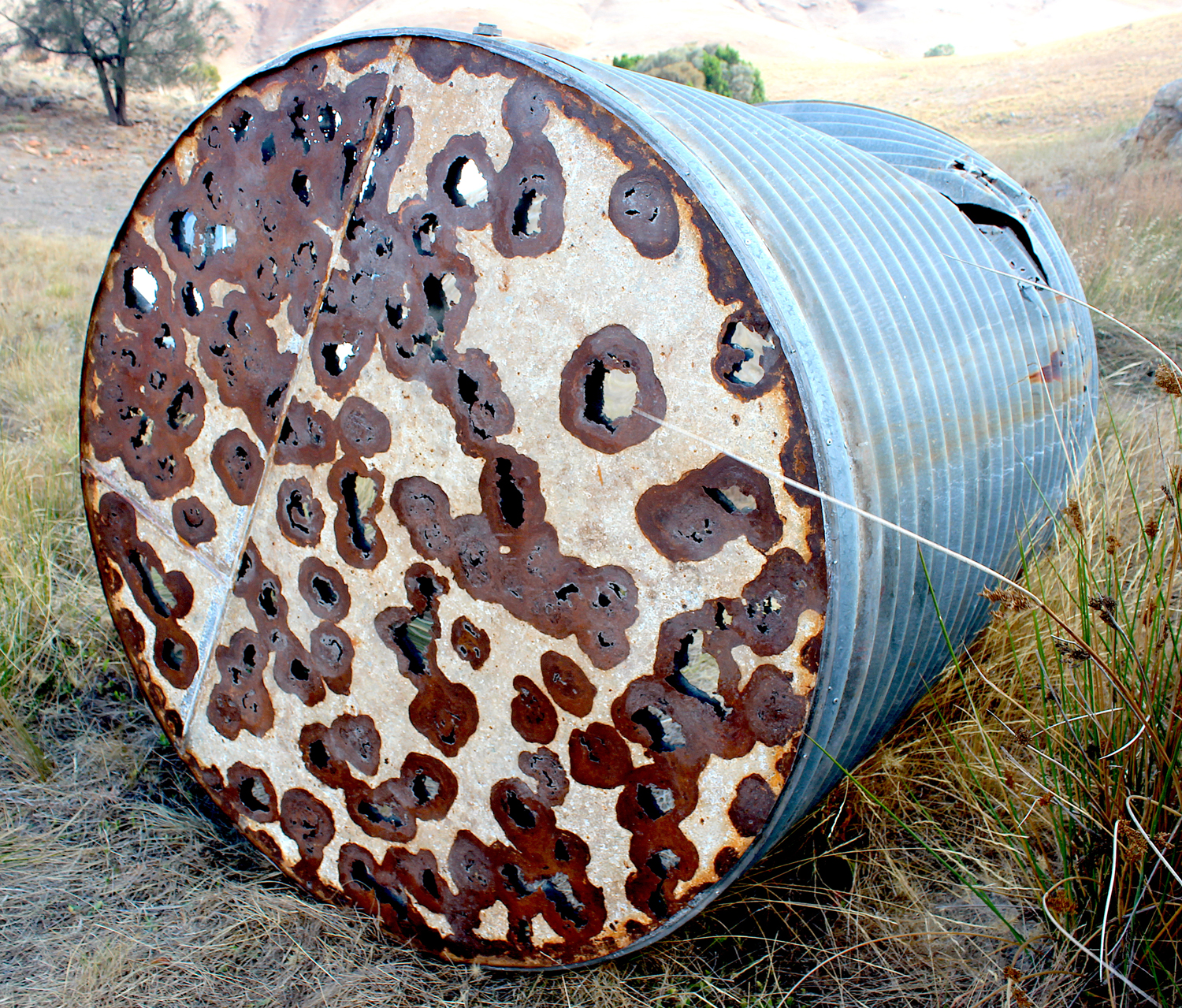
On Reflection, by Liz Butler. Photo: John Neylon
Westley Tully chose his site because the outcrop of stones and bushes reminded him of a cemetery. In this space he has sited a beaten-up old wheelbarrow and, within this, a series of weathered timber offcuts arranged to form a pyramid. For the artist, this humble installation, Towards an End, is layered with symbols variously referencing the burdens carried through life, priorities adopted and life’s challenges.
“The pyramidal pinnacle,” Tully says “represents and exit, the demise or an end of one’s existence.” The reference to Palmer’s own life cycle is evident.
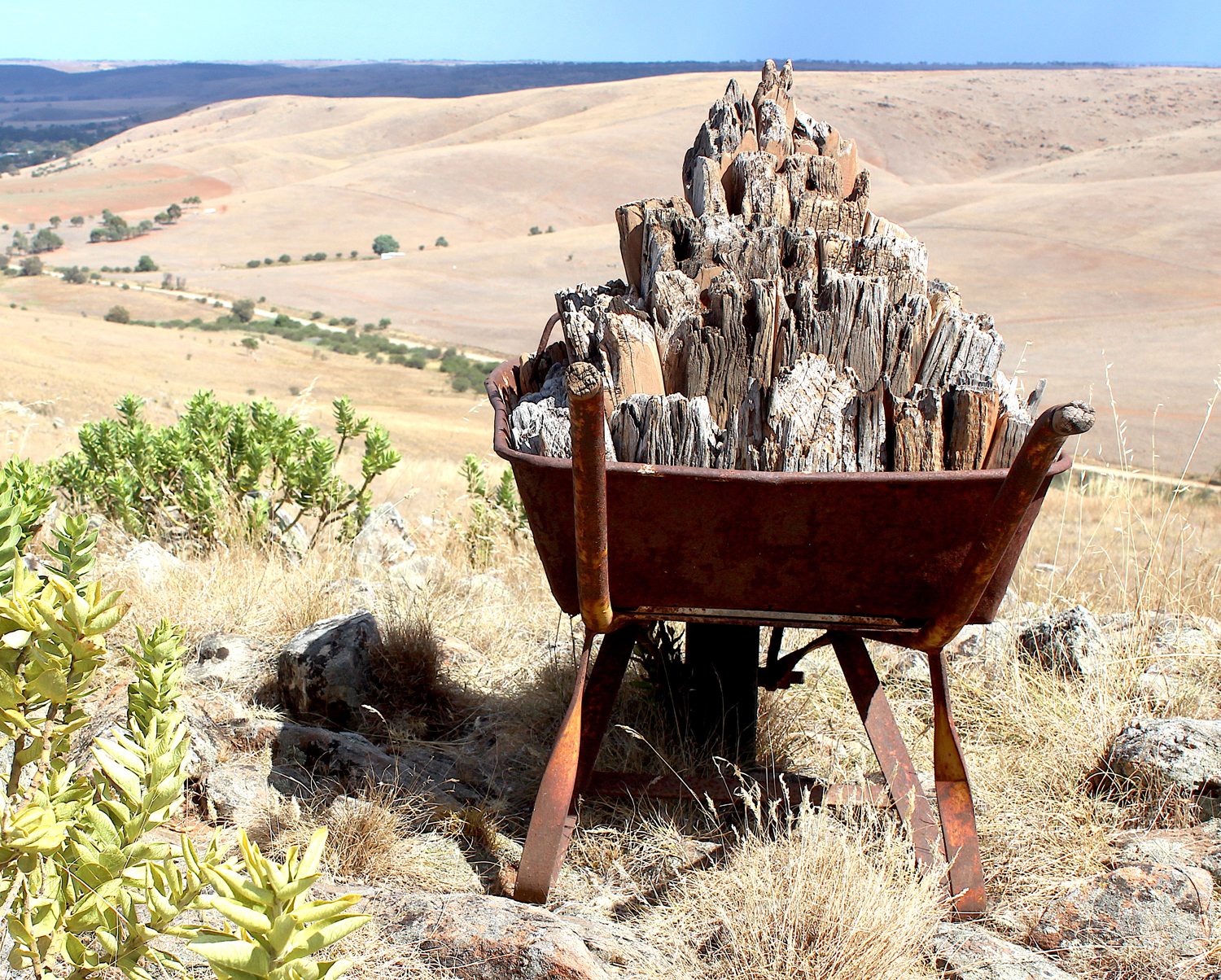
Towards an End, by Westley Tully. Photo: John Neylon
Clancy Warner has used a see-through device calculated to draw attention to the specifics of space while making bigger statements about the state of the world. Her figurative piece is characteristic at one level of her previous Palmer offerings – an upright figure in a hieratic pose. The artist says that the sculpture “invites the viewer to delve into the different aspects and intersections of the self … Looking through the figure encourages examination of the ‘self’ as a both a product and reflection of the immediate environment”.
Another figurative work, Gathered Skylark, by Sian Watson, also utilises the dramatic potential of ridge-top siting. Watson sees in the gesture of her conjoined figures with zoomorphic features gazing into the heavens as “representative of movement, migration and cohabited future”.
This idea of imagining an alternative, cautiously utopian future, while drawing on the visual resources of the landscape, is a consideration and tactic used by others. Astra Parker, for example, in her work Suññatā, has relinquished her customary lace-like orbital form in favour of a delicate lozenge of galvanised steel units which coalesce and dissolve in the glaring sunlight. The artist says that the work “investigates the idea of the self as a permeable form… it questions how much one is the self and how much part of the other”.
Parker’s mandalic form springs from the earth. Greg Johns’ The Kiss dives into it, leaving only the gesture of a kiss (made famous by Brâncuși et al) to suggest that the real action takes place below, subterranean forces at work, he believes, a “new embrace and contract with the land”.
This transformative theme, co-opting or raiding the Palmer landscape for ready-made symbols, holds powerful sway across the exhibition. The most dramatic example is the collaborative (Anika Gardner and Stelarc) work rockProsthesis (metal, muscles, code). A large boulder has been draped with lengths of metal strips attached to wires activated by pneumatic tubing anchored into the surrounding rocks. As compressed air fills the tubes, the metal strips are dragged across the boulder to the accompaniment of scraping and squeaking noises, along with wheezes from the compressed air.
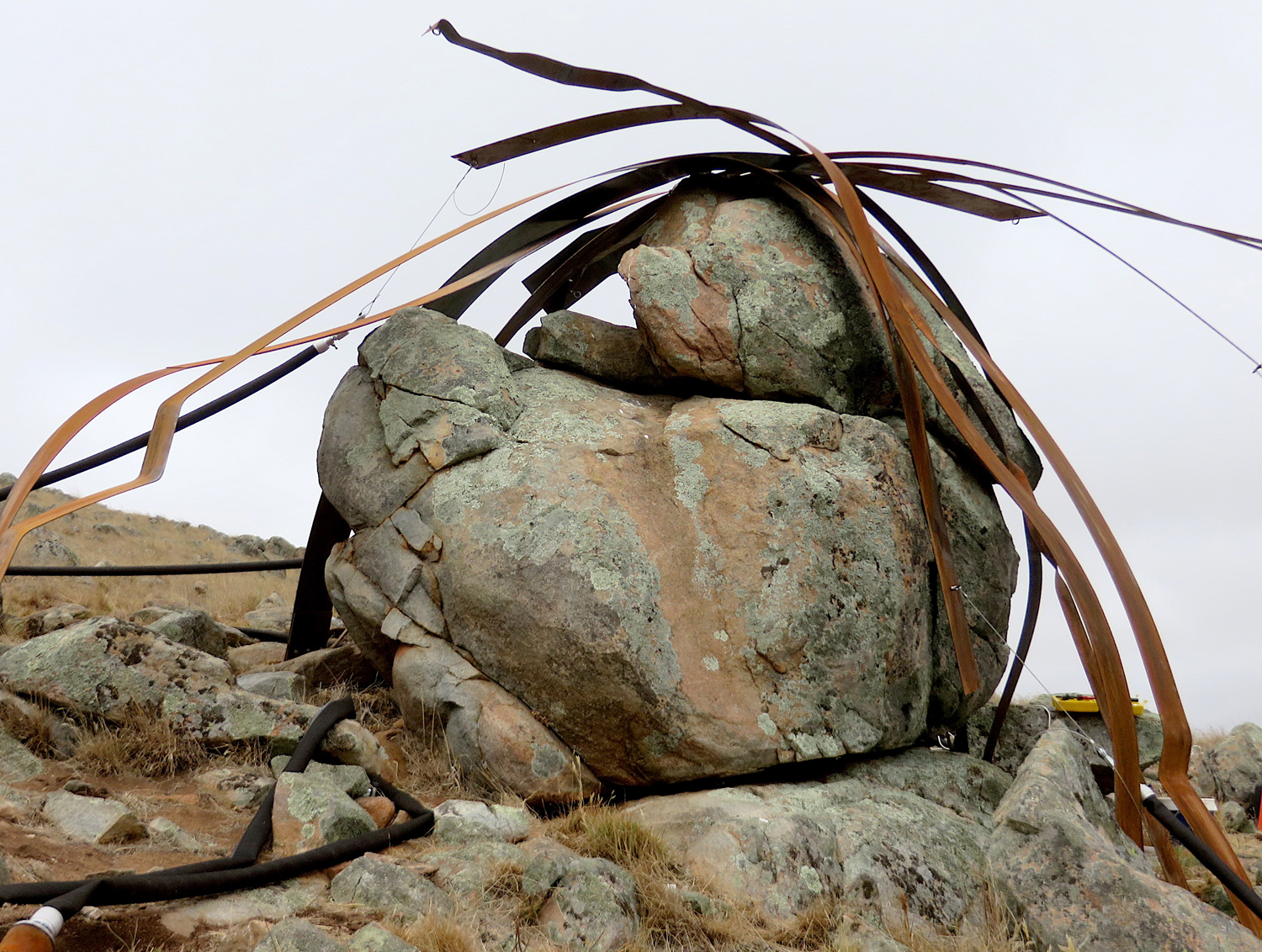
rockProsthesis (metal, muscles, code), by Anika Gardner and Stelarc. Photo: John Neylon
Of this work, Gardner and Stelarc say “through the software system animating the rock formation, evocations of the industrial … this object/being exists in a world where the delineations of the industrial/technological/natural are obfuscated into symbols”. Whatever interpretation is offered, this work set high on a hillside makes a powerful and memorable visual statement, with underlying sinister notes of future exoskeletal hybridities.
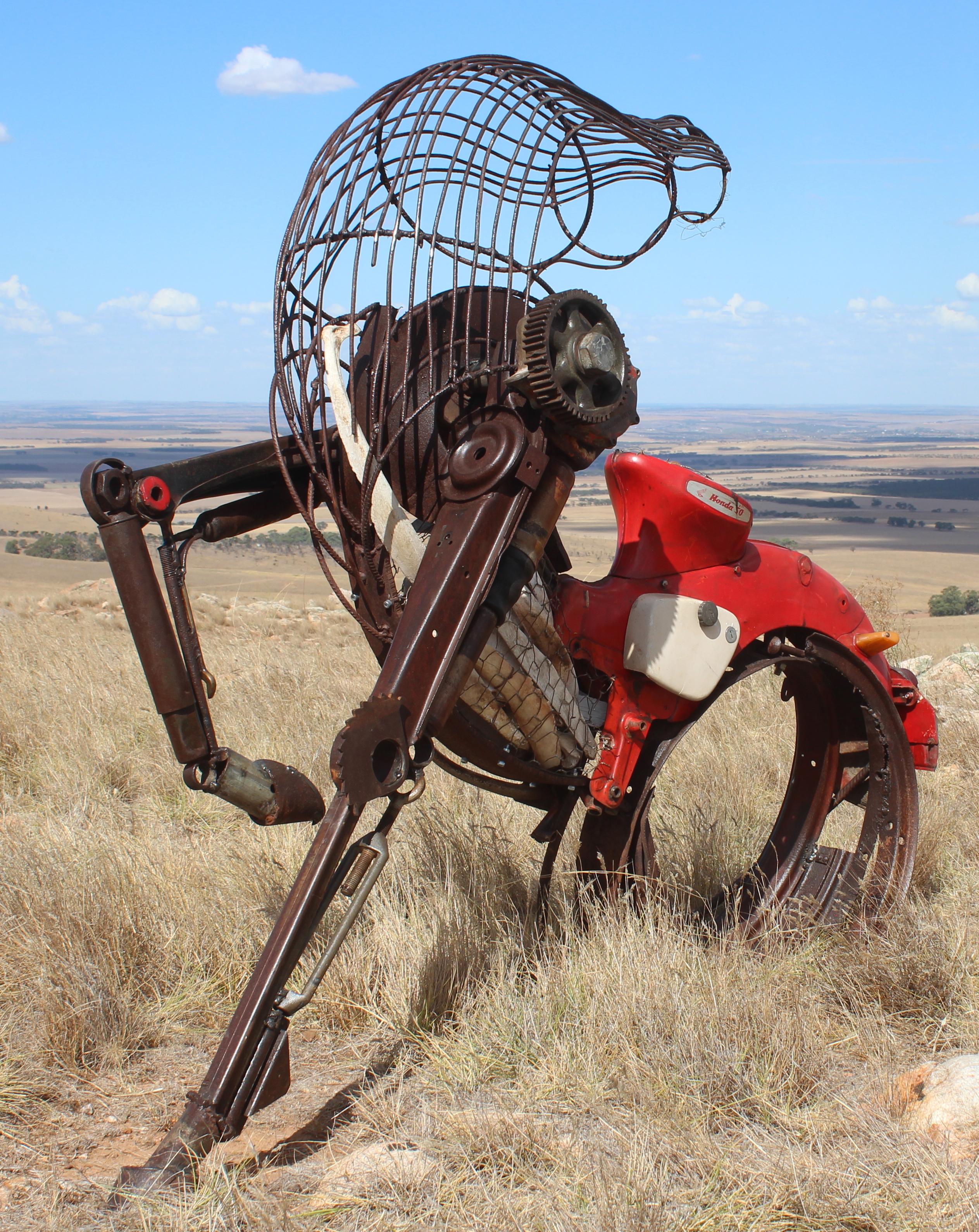
Dying Centaur, by Will Powrie. Photo: John Neylon
Over the hill, Will Powrie’s Dying Centaur, in synthesizing the body of a horse and a human head, bonded to a Mad Max-like motorcycle, echoes the Gardner/Stelarc speculation about future life. The act of siting the two works by Powrie in isolation high on an escarpment suggests banishment, as if this idea is somewhat repugnant. So like any good hermit it may have to hang out in the bad lands until its time has come.
Intentionally or otherwise, Alan Todd’s Orion, an installation of markers topped with totemic symbols, evokes an “out there” promise of possibilities which renders this patch of Palmer a transmission complex, messaging other life forms that might care to listen. Similar interpretations can be applied to Cliff Burtt’s Azimuth, a series of transmission tower lookalikes with solar-powered beacons.
From such futures referencing, Palmer 2024 is marginally distinctive from previous PSBs but nevertheless subscribes to the project’s core business of finding ways of co-opting the landscape to play along with ideas. Fortunately for the art pilgrims who wend their way across the vast force field of experimental play, there are many works which are reassuringly “old school” in observance of aesthetic and visual relationships. This gully, that ridge-top, those outcrops, that soak, line of trees, a bulge in a rock, the jump cuts between near and far – such things have clearly mattered very much.
John Hayward’s serpentine panel, Serpent Emerging, is sited to appear as if floating above a bed of reeds. The spindly ground-sites units of Vic Waclawick’s Ghosts of the Murray Valley, while referencing deforestation, visually echo the ridgeline of an overlooking hill. Niccy Pallant’s Cue: Tumbleweed sets linear orbs dancing with trees in “forlorn and lonely spaces”.
To walk such a vast, dramatic landscape in search of art constitutes a modern-day experience like no other. So, gird your loins, put on your stoutest shoes and embrace your right, in this secular age, to be a Palmer Pilgrim.
Palmer Sculpture Biennial 2024 also features two painting exhibitions: Dr Maarten Daudeij, The Glow Suite: Celebrations of a Seeing (1-V1) (The Round House), and John Neylon, My Palmer Rocks (The Hut). The Biennial is open until April 14 (weekends 11am-5.30pm and Wednesdays 2pm-5.30pm.
This article is republished from InReview under a Creative Commons licence. Read the original article.
InReview is an open access, non-profit arts and culture journalism project. Readers can support our work with a donation. Subscribe to InReview’s free weekly newsletter here.
![]()




